Ijraset Journal For Research in Applied Science and Engineering Technology
- Home / Ijraset
- On This Page
- Abstract
- Introduction
- Conclusion
- References
- Copyright
Electric Handcart Integrated with Solar Charging Hub
Authors: Mohanraj M, Sugan M, Shivanesan B, Kapil A
DOI Link: https://doi.org/10.22214/ijraset.2024.66056
Certificate: View Certificate
Abstract
In several Asian countries, three-wheeled vehicles called hand carts are commonly used as people and goods taxis. The vehicle\'s design is simple and unproductive, yet it fits the environment it operates in rather well. The increasing need for sustainable and effective transportation solutions has led to the need for upgrades for traditional handcarts, which are commonly used to convey goods in both urban and rural settings. The purpose of this project is to design and construct an electric handcart as a more efficient and greener substitute for manual carts. An electric motor on the electric handcart will aid in transporting heavy objects, reducing the physical strain on users. It will run on a system of rechargeable batteries. The design incorporates elements such as an LED display, a battery management system, and a solar panel that serves as a charging hub to increase the use of the cart. The handcart will be lightweight but durable, constructed using sustainable materials.
Introduction
I. INTRODUCTION
First, for small-scale vendors, farmers, and laborers in both urban and rural locations, handcarts are a necessary mode of transportation for goods in many developing nations. However, these antiquated carts, which rely only on human effort, can occasionally be physically draining and inefficient, particularly when large loads need to be moved across rough terrain or over long distances. The need for solutions that tackle these problems and promote environmental responsibility is growing as the global demand for more sustainable and efficient technologies rises. The electric handcart offers a feasible alternative by combining the practicality of traditional handcarts with modern electric propulsion technologies. The electric handcart significantly reduces the amount of physical labor needed thanks to its electric motor and rechargeable battery. Innovative modifications of conventional techniques have resulted from the need for easy and effective urban transportation solutions. The goal of this project is to convert a regular handcart into an electric one that is intended for vegetable sales. Incorporating electric support targets to develop a sustainable and user-friendly solution for vegetable sellers by improving mobility and lessening the physical strain on vendors, enabling them to travel farther with ease.
II. LITERATURE SURVEY
In [1], Priscilla Mulhall and Ali Emadi, the authors of the paper: In order to analyse the performance, fuel economy, and emissions of the different vehicle types, including conventional, electric, hybrid electric, and fuel cell vehicles, this study made use of the ADVISOR tool (Advanced Vehicle Simulator), This tool is a collection of MATLAB/Simulink models, data, and scripts. A modified 15.8 kW permanent magnet motor/controller from the ADVISOR tool was utilized as the model's motor and controller. To create typical driving cycles for both daylight and evening driving circumstances, GPS data from Indian autorickshaws was gathered.
The effectiveness, vehicle gradeability, and acceleration capabilities of the electric rickshaw with varying motor sizes and speeds were examined using simulations conducted in ADVISOR. Increasing the efficiency and lowering the emissions of India's traditional autorickshaws, which presently run on inefficient gasoline engines with two or four strokes. creating a design for an electric autorickshaw that uses solar energy in addition to batteries to provide a longer range. Since the vehicle's electric propulsion system is its only source of power, it must be properly optimized. A reputable and verified vehicle modelling platform, ADVISOR is capable of simulating conventional, hybrid, and electric powertrains. It offers the accuracy and adaptability required to examine the intricate relationships among the motor, controller, batteries, and vehicle dynamics.
In [2], Malik Sameeullah and Sunita Chandel, the authors of the paper: The article examines the body of research on e-rickshaws, including studies on their powertrain, chassis, and energy sources. In order to lower the total weight of the modified vehicle, it primarily addresses the parts that can be taken out or swapped out for lighter materials throughout the retrofitting process.
According to the AIS 123 criteria for construction and functional safety requirements, the modified vehicle must pass a number of tests. Internal combustion engines powered by fossil fuels are used in conventional autorickshaws, which contribute to greenhouse gas emissions and environmental pollution.
Auto rickshaw electrification can contribute to emissions reduction and the transition to environmentally friendly transportation. By transforming the current conventional autorickshaws into electric ones, the retrofitting method prolongs their useful lives and eliminates the need to trash them. Compared to buying new electric models, retrofitting enables improving the current vehicles at a reduced cost. It makes it possible for the fleet of public transportation to gradually become electrified. By maintaining the familiar layout and seating arrangement, retrofitting facilitates a smoother and more palatable changeover for riders. Since the retrofitting method entails altering the current vehicle's structure and parts to make room for the electric drivetrain, it is technically possible.
In [3], V. L. Kokate, Sahil. S. Uttekar, P. B. Karandikar, R. M. Holmukhe were the authors of this paper. They suggested solar charging station design was optimized using HOMER software. It was employed to ascertain the grid-photovoltaic system's ideal setup for the charging station.
To lessen the effect of partial shading, a brand-new Maximum Power Point Tracking (MPPT) algorithm was put forth. Creating a model of a solar-powered hybrid electric rickshaw and evaluating the suggested solar e-rickshaw system's functionality, energy production, and economic feasibility. assessing how the performance of the rickshaw is affected by PV system loads. Enhancing Maximum Power Point Tracking (MPPT) algorithm is to increase the performance of the photovoltaic system while it is partially shaded.
A popular program for optimizing hybrid renewable energy systems, such as solar-powered charging stations, is called HOMER. It assists in figuring out the best grid-connected solar charging station layout in terms of component sizes, cost, and the percentage of renewable energy. In order to develop a sustainable and economical charging infrastructure for the solar e-rickshaws, HOMER's optimization capabilities are essential. The research becomes more realistic and pertinent to the local context when real-world data is gathered from the field, such as e-rickshaw routes, usage trends, and operational conditions. For the simulation and analytical results to be validated, field data is essential.
Because e-rickshaws operate in crowded metropolitan areas, partial shading is a common problem for PV systems mounted on these vehicles. Partial shading's effects and the creation of a better MPPT algorithm maximize the PV system's energy output, improving the solar e-rickshaw's overall viability and performance.
.In [4], Namitha Murali, S. Ushakumari, Mini V.P and Alen Toji Varghesee, the authors of the paper. The entire E-rickshaw dynamics, including rolling resistance, grading resistance, aerodynamic drag, and acceleration resistance, are covered in the study. Both flat roadways and sloped terrain have these forces computed and modeled mathematically. For the E-rickshaw application, the design of a 2kW permanent magnet synchronous motor (PMSM) is used in this research. This Ansys software's RMxprt and Maxwell 2D platforms are used to virtually construct and assess the intended PMSM. Simulation is used to assess the PMSM's efficiency, magnetic flux density distribution, speed-torque characteristics, and transient and steady-state performance. To do additional analysis, the created PMSM's RMxprt model is exported to the Maxwell 2D platform.
The FEA-based simulations in Maxwell 2D are used to assess the PMSM's transient and steady-state performance, including efficiency, magnetic flux density distribution, and speed-torque characteristics. Prior to actual construction, the researchers can confirm that the designed PMSM satisfies the requirements for the E-rickshaw application by using the FEA analysis. The performance of the intended machine can be confirmed through the physical building of the PMSM and virtual development and analysis based on Finite Element Analysis. Without using actual prototyping, FEA allows the researchers to optimize the design parameters if needed. The PMSM's transient and steady-state behavior, including speed-torque characteristics, losses, and magnetic flux distribution, are thoroughly examined by the FEA simulations in Ansys Maxwell.
III. OBJECTIVE
The following are the project's main goals:
- Making an electric handcart out of a conventional one to increase mobility.
- To make it simpler for merchants to transport their wares so they can sell them farther and with less effort.
- For the environmentally friendly modes of transportation that nearby suppliers may use to improve business operations.
- Reducing the amount of human labor needed to move the handcart.
IV. Block Diagram
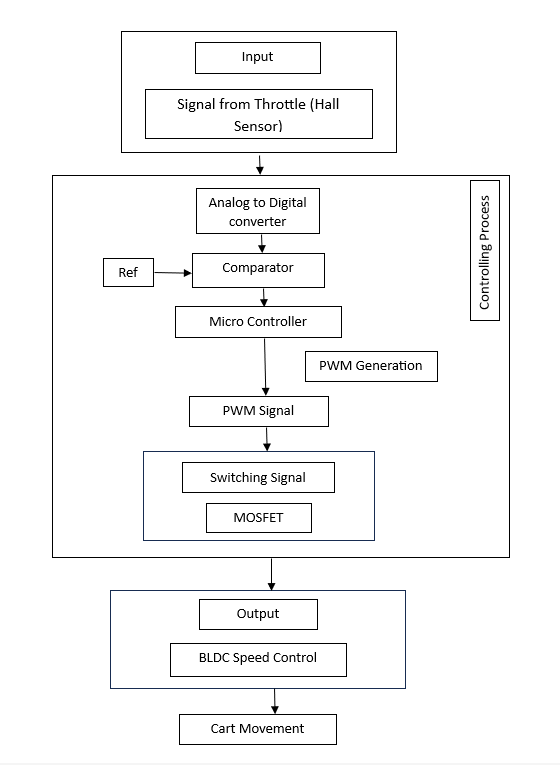
Fig. 1 Block diagram of the proposed work
V. SPECIFICATIONS
A. Battery Management System
Rechargeable batteries (such as lithium-ion) are managed by a BMS, which balances the battery cells, prevents overcharging, and guarantees peak performance. Additionally, it is employed to detect temperature, voltage, and current. To make sure the battery is not overcharged or undercharged, a voltage sensor is employed to monitor its voltage. Temperature sensors are used to keep an eye on the battery's temperature and guard against overheating, which could result in damage or safety risks. The flow of current into and out of the battery pack during cycles of charging and discharging is measured by current sensors.
B. Crash detection
Using sound waves at a frequency greater than human hearing, an ultrasonic sensor works (usually 20 kHz and above). An ultrasonic sound wave is released by the sensor's transmitter. This sound wave propagates through space until it collides with an item. The sound wave bounces back toward the sensor after colliding with an item. The returning echo is picked up by the sensor's receiver. The sensor calculates the amount of time required for the pulse to reach the target and get back. This sensor determines the distance to the item by utilizing the speed of sound, which is roughly 343 meters per second at ambient temperature. A tiny controller uses the time difference between transmission and reception to calculate the distance.
C. Solar charging hub
Electric rickshaws (or e-rickshaws) may be efficiently and sustainably charged with the help of a solar charging station that integrates battery charging technology with solar energy generation. By lowering dependency on fossil fuels and the grid for electricity, this kind of hub can be utilized in both rural and urban settings to support renewable energy. It can also be utilized to charge an additional electric car.
D. LED display
Light-emitting diodes (LEDs) are a type of flat-panel display technology that can produce text, images, and movies. The cost of the offer is displayed using LED screens. They are perfect for advertising in bright daylight and at night due to their high brightness and visibility.
E. Bluetooth speaker
Without the need for cords, Bluetooth speakers let consumers stream music from their smartphones. They provide mobility and simple coupling. Most Bluetooth speakers are lightweight, compact, and carry-anywhere, which makes them ideal for outdoor activities. We use it in our cart to announce the prices of the provisions that we sell.
F. Ambient lighting
In addition to ensuring comfortable sight without producing harsh shadows or overly bright areas, ambient lighting gives space an overall illumination. A room's light intensity is usually uniform and balanced since it is soft and diffuse. Ambient lighting ensures that individuals can walk around safely and comfortably without straining their eyes or tripping in the dark by providing general visibility.
VI. FLOWCHART
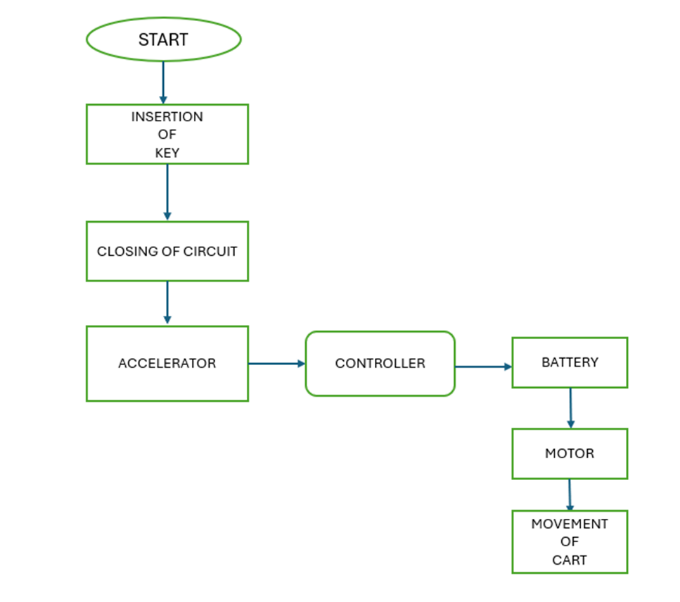
Fig.2 Flowchart of proposed work
When the key is turned on and the battery starts to power all of the circuits, the circuit is finished. The accelerator or throttle located next to the handle is used to change speed. When the throttle is twisted, an electrical signal is generated and transmitted to the controller, which recognizes it, converts it into a motor power supply flow, and adjusts the power supply based on the actuator's electrical signal's amplitude. The wheel then starts to rotate as the motor converts the electrical energy to mechanical energy. The motor is unplugged, the brake is applied, and the supply is passed through when we want to stop the car.
VII. REQUIREMENTS
A. Electric Motor
A 250-watt geared BLCD electric motor with a voltage of 24 volts and 12 amps.
- 300 revolutions per minute.
- About a 1:5 gear ratio is used.
- The motor produces a torque of roughly 8 nm.
B. Battery pack
Because of its high energy density, low weight, and extended life cycle, lithium-ion batteries are used. Energy: 316.8 Watts
- 8.8 Ah of capacity.
- Output Voltage: 36 V.
- Two to three hours for charging.
C. Controller
A 24-volt, 250-watt DC bicycle motor speed controller with gearing.
D. Bicycle components:
- Attachment - A 360-degree rotating xyz plain bearing with a spring-loaded arrangement.
- Connecting plate - ID66 connecting plate, measuring 70 mm in length and 4 mm in thickness.
- Throttle - The motor that is connected to the controller and motor is accelerated using a thumb throttle.
- Extra Materials - Reinforcements for the handcart structure and connectors, as well as safety measures like brakes and lights.
VIII. METHODOLOGY
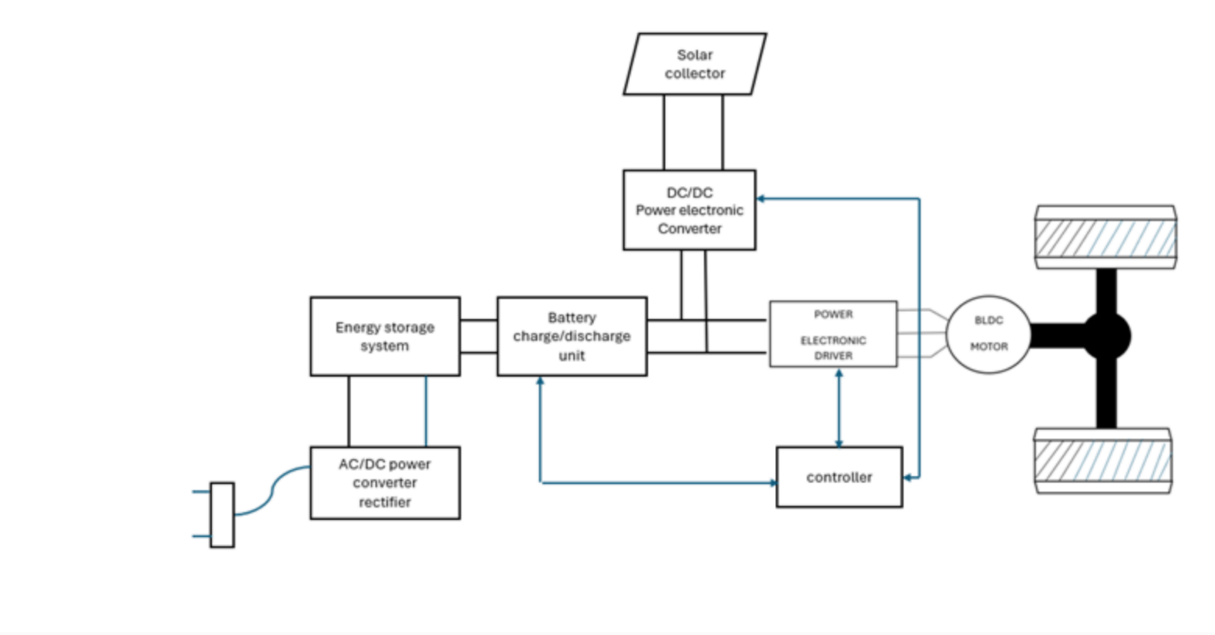
Fig.3 Block diagram of proposed work
IX. 3D MODEL
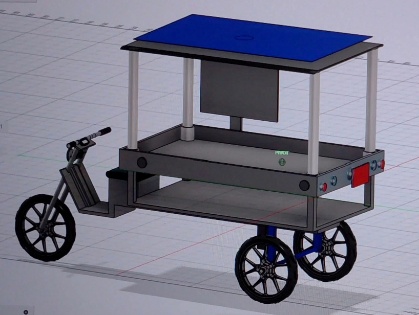
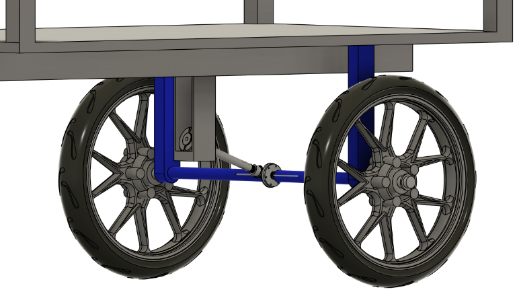
Fig.4 Side view of cart Fig.5 Wheels of the cart
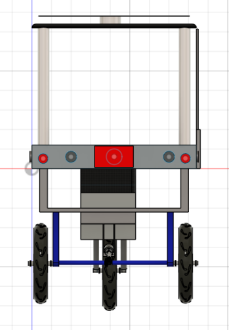
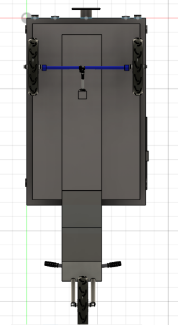
Fig.6 Front view of cart Fig.7 Bottom view of vehicle
Conclusion
In addition to strengthening local economies, this project encourages sustainable practices by improving mobility and reducing physical strain by giving vendors better tools for their profession. Vendors will be able to expand their market reach and increase their potential sales as a result. Converting the handcart to an electric one can increase the effectiveness of vegetable sales. The cart in this system employs photovoltaic panels to capture solar energy, which is minimal maintenance and non-polluting. Vendor mobility and ease of use will be enhanced by the cart\'s highly efficient BLDC motor, which is powered by a sturdy battery system. It\'s better for cities since it lasts longer, is more efficient, and produces less noise. Better energy management decisions may be made thanks to real-time monitoring devices that can track solar input, battery health, and energy consumption. The battery may be charged using a solar panel, and it can also be used as a small charging hub, which is useful for charging other cars. In addition to empowering small businesses and advancing the new world of renewable energy, this concept has enormous potential for expanding up.
References
[1] P. Mulhall and A. Emadi, \"Comprehensive simulations and comparative analysis of the electric propulsion motor for a solar/battery electric auto rickshaw three-wheeler,\" 2009 35th Annual Conference of IEEE Industrial Electronics, Porto, Portugal, 2009, pp. 3785-3790, doi: 10.1109/IECON.2009.5415374. keywords: Analytical models;Propulsion;Hybrid electric vehicles;Power electronics;Battery powered vehicles;Control systems;Intelligent vehicles;Electric motors;Pollution;Vehicle driving;Batteries;control;drive trains;efficiency maps;electric motors;electric propulsion;electric vehicles;energy storage systems;modeling and simulations;power electronics;propulsion systems;solar cells;three-wheelers} [2] V. L. Kokate, S. S. Uttekar, P. B. Karandikar and R. M. Holmukhe, \"Retrofitting of Auto Rickshaw to E-Rickshaw - A Feasibility Study,\" 2020 First International Conference on Power, Control and Computing Technologies (ICPC2T), Raipur, India, 2020, pp. 229-234, doi: 10.1109/ICPC2T48082.2020.9071492. keywords: Batteries;Automobiles;Companies;Public transportation;Electric vehicles;Renewable energy sources;Petroleum;Retrofitting;Auto rickshaw;E-Rickshaw} [3] M. Sameeullah and S. Chandel, \"Design and analysis of solar electric rickshaw: A green transport model,\" 2016 International Conference on Energy Efficient Technologies for Sustainability (ICEETS), Nagercoil, India, 2016, pp. 206-211, doi: 10.1109/ICEETS.2016.7582927. keywords: {Batteries;Vehicles;Engines;Urban areas;Loading;Analytical models;Wheels;Renewable Energy System; Auto Rickshaw; Electric Vehicle;Solar PV System;Solar electric rickshaw;Solar Charging Station} [4] N. Murali, S. Ushakumari, V. P. Mini and A. T. Varghesee, \"Sizing and Performance Analysis of an Electric Motor in an E-rickshaw,\" 2020 IEEE International Conference on Power Systems Technology (POWERCON), Bangalore, India, 2020, pp. 1-6, doi: 10.1109/POWERCON48463.2020.9230564. keywords: {Vibrations;Renewable energy sources;Power system measurements;Torque;Roads;Power system dynamics;Electric vehicles;Electric vehicle (EV);E-rickshaw dynamics;PMSM;FEA;RMxprt;Maxwell 2D} [5] H. Bisht and G. Udupa, \"Electric Regenerative Hybrid System For A Traditional Auto-Rickshaw,\" 2021 3rd International Conference on Electrical Engineering (EECon), Colombo, Sri Lanka, 2021, pp. 37-42, doi: 10.1109/EECon52960.2021.9580958. keywords: {Power distribution;Internal combustion engines;Wheels;Lithium;Ions;Hybrid power systems;Mathematical models;Hybrid design;Auto-Rickshaw;Regenerative;BLDC motor;Lithium battery;MPD}, [6] A. V. Nambiar, E. Lawrence P, J. John, N. V. Philip, K. P. Thomas and E. R. Samuel, \"Economical Electric Rickshaw from Conventional Engine Rickshaw,\" 2019 2nd International Conference on Intelligent Computing, Instrumentation and Control Technologies (ICICICT), Kannur, India, 2019, pp. 560-565, doi: 10.1109/ICICICT46008.2019.8993320. keywords: {Electric vehicle;Brushless DC motor;controller;solar panel}, [7] D. Sahu and P. S. R. Nayak, \"A Substantial Modelling and Analysis of Solar Powered e-Rickshaw Drive System,\" 2021 International Conference on Sustainable Energy and Future Electric Transportation (SEFET), Hyderabad, India, 2021, pp. 1-6, doi: 10.1109/SeFet48154.2021.9375651. keywords: {Analytical models;Torque;DC motors;Batteries;Performance analysis;Load modeling;Electric motors;e-Rickshaw;battery bank;drive system solar battery charger;DC motor}, [8] O. Ray, M. S. Rana, S. Mishra, K. Davies and S. Sepasi, \"Battery-swap Technology for e-Rickshaws: Challenges, Opportunity and Scope,\" 2020 21st National Power Systems Conference (NPSC), Gandhinagar, India, 2020, pp. 1-6, doi: 10.1109/NPSC49263.2020.9331876. keywords: {Green products;Wheels;Transportation;Microgrids;Electric vehicles;Batteries;Power systems;Battery Swap Technology;Electric Rickshaw;Lead Acid Battery},
Copyright
Copyright © 2024 Mohanraj M, Sugan M, Shivanesan B, Kapil A. This is an open access article distributed under the Creative Commons Attribution License, which permits unrestricted use, distribution, and reproduction in any medium, provided the original work is properly cited.

Download Paper
Paper Id : IJRASET66056
Publish Date : 2024-12-22
ISSN : 2321-9653
Publisher Name : IJRASET
DOI Link : Click Here
 Submit Paper Online
Submit Paper Online

